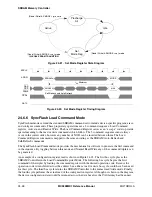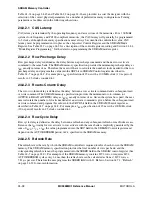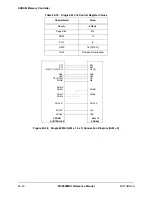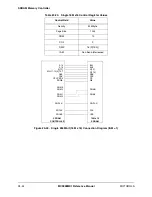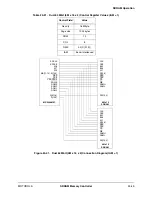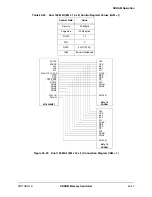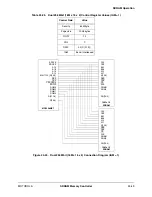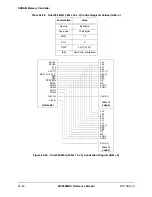
General Operation
MOTOROLA
SDRAM Memory Controller
24-35
Figure 24-31. Powerdown Mode Resulting From Reset with Refresh Disabled
24.7.4 Clock Suspend Low-Power Mode
SDRAM and SyncFlash memories incorporate a command sequence to disable the clock input buffer and
suspend internal activity, lowering power consumption as much as an order of magnitude. The SDRAM
Controller implements a clock suspend time-out mechanism to take advantage of this feature. Several
software selectable time-outs are provided to accommodate for varying system conditions, with the
time-out condition being specified in the Clock Suspend Timeout (CLKST) field in the SDCTLx register.
The feature is disabled out of reset.
SDRAM/SyncFlash clock suspend actually consists of two sub-modes: Clock Suspend and Powerdown.
The distinguishing factor between the two is whether banks remain active while the clock is stopped.
Clock suspend allows banks to remain activated, while Powerdown does not.
24.7.4.1 Powerdown
Programming CLKST [1:0] = 01 causes the SDRAM Controller to place the memories in powerdown
mode anytime the controller detects that no banks are active. This mode is useful in applications where a
memory array is accessed infrequently and the chances of another access to the same page are minimal.
Reading or writing to memory activates a page within the addressed bank. Reset, software generated
precharge, and hardware initiated refresh are three ways to close an active bank. The periodically occurring
refresh will be the normal means that invokes the powerdown mode. At each refresh interval, all banks will
be closed by a precharge-all command, followed by the refresh operation. The controller will then issue the
powerdown command to the memories. A few cycle delays are incurred with the first read or write cycle to
restart the clocks, however only on the first cycle. After that, the clocks will continue to run until the next
refresh operation or until any active banks are manually precharged.
Page misses on read and write cycles cause the addressed bank to be closed (precharged) and a new page
opened within the bank. This operation does not cause the clocks to stop, nor does manually precharging
only a single bank within the memory. All banks within the memory must be inactive before the
powerdown mode is invoked.
m_rst
SDCLK
ADDR
RAS,
CAS,
SDWE
CSDx
DATA
PRE-ALL
A10 = 1
SDCKEx
NOP
NOP
DATA
A
Summary of Contents for DragonBall MC9328MX1
Page 68: ...1 12 MC9328MX1 Reference Manual MOTOROLA Introduction ...
Page 86: ...2 18 MC9328MX1 Reference Manual MOTOROLA Signal Descriptions and Pin Assignments ...
Page 116: ...3 30 MC9328MX1 Reference Manual MOTOROLA Memory Map ...
Page 126: ...4 10 MC9328MX1 Reference Manual MOTOROLA ARM920T Processor ...
Page 160: ...8 8 MC9328MX1 Reference Manual MOTOROLA System Control ...
Page 272: ...13 32 MC9328MX1 Reference Manual MOTOROLA DMA Controller ...
Page 281: ...Programming Model MOTOROLA Watchdog Timer Module 14 9 ...
Page 282: ...14 10 MC9328MX1 Reference Manual MOTOROLA Watchdog Timer Module ...
Page 300: ...15 18 MC9328MX1 Reference Manual MOTOROLA Analog Signal Processor ASP ...
Page 438: ...18 16 MC9328MX1 Reference Manual MOTOROLA Serial Peripheral Interface Modules SPI 1 and SPI 2 ...
Page 478: ...19 40 MC9328MX1 Reference Manual MOTOROLA LCD Controller ...
Page 574: ...21 32 MC9328MX1 Reference Manual MOTOROLA Memory Stick Host Controller MSHC Module ...
Page 598: ...23 16 MC9328MX1 Reference Manual MOTOROLA Real Time Clock RTC ...
Page 670: ...24 72 MC9328MX1 Reference Manual MOTOROLA SDRAM Memory Controller ...
Page 726: ...25 56 MC9328MX1 Reference Manual MOTOROLA SmartCard Interface Module SIM ...
Page 736: ...26 10 MC9328MX1 Reference Manual MOTOROLA General Purpose Timers ...
Page 854: ...29 18 MC9328MX1 Reference Manual MOTOROLA I2C Module ...
Page 900: ...30 46 MC9328MX1 Reference Manual MOTOROLA Synchronous Serial Interface SSI ...
Page 942: ...32 26 MC9328MX1 Reference Manual MOTOROLA GPIO Module and I O Multiplexer IOMUX ...






